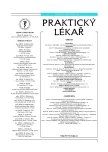Abused child syndrome
Syndrom týraného dítěte – fyzické týrání
Autor se v práci zabývá skupinou týraných dětí. Stanovení diagnózy fyzického týrání u dětí je dokumentováno u vlastního souboru a analyzováno podle zkušeností různých autorů. U týraných dětí bývá neodůvodněné zpoždění při vyhledání lékařské péče, chybí věrohodné vysvětlení příčiny úrazu či je úraz zcela popírán. Při klinickém vyšetření zjišťujeme škrábance a podlitiny různého stáří na tváři, hýždích a zádech. Zlomeniny kostí mohou být mnohočetné, různého stáří a v jiných místech než u náhodných úrazů. Bývají i zlomeniny žeber a lebky. Nejčastější příčinou morbidity a mortality týraných dětí jsou nitrolebeční poranění. Nejčastěji jde o subdurální hematom v kombinaci s kontuzí mozku. U dětí do 6 měsíců je jasně definovanou podskupinou tzv. syndrom třeseného dítěte. Zde chybí zevní známky úrazu, jsou přítomny vícečetné hemoragie na sítnici a subdurální hematom z poranění přemosťujících žil. V práci se připomíná nově popsaný mechanismus poranění dítěte, kdy je dítě při rvačce mezi rodiči užito jako ochranný štít.
Klíčová slova:
týrané dítě – bité dítě – syndrom třeseného dítěte – nitrolebeční poranění – nenáhodný úraz.
Authors:
L. Navrátil
Authors‘ workplace:
Neurochirurgické oddělení FN, Plzeň
přednosta prim. MUDr. M. Choc, CSc.
Published in:
Prakt. Lék. 2005; 85(1): 38-42
Category:
General Medicine
Overview
The paper describes a group of 9 abused children, who were treated at the Department of Neurosurgery in Pilsen. The subject matter of child abuse (physical maltreatment) is analysed on own group and on opinion of many authors. There is delay in seeking medical care without adequate reason and trustworthy explanation of cause of trauma (lack of, discrepant or implausible history). By clinical examination we can often see bruises, welts and grasp marks of various age on the face, buttock and back. Intracranial traumas are most often causes of morbidity and mortality of abused children. The subdural haematoma with or without cerebral contusion are more frequent. Among the abused children under 6 month of age there is clear defined subgroup of the „Shaken Baby Syndrome“. There are no visible external marks of the trauma in those children. There are typical retinal hemorrhages and subdural hematomas arising from bridging veins in those cases. The new entity of mechanism of injury, were the child is used as part of shielding in crossfire between fighting parents, is mentioned.
Key words:
abused child – battered child – shaken baby syndrome – intracranial injury – inflicted head injury – non-accidental injury.
Labels
General practitioner for children and adolescents General practitioner for adultsArticle was published in
General Practitioner

2005 Issue 1
- Metamizole at a Glance and in Practice – Effective Non-Opioid Analgesic for All Ages
- What Effect Can Be Expected from Limosilactobacillus reuteri in Mucositis and Peri-Implantitis?
- Metamizole in perioperative treatment in children under 14 years – results of a questionnaire survey from practice
- Memantine Eases Daily Life for Patients and Caregivers
- Possibilities of Using Metamizole in the Treatment of Acute Primary Headaches
Most read in this issue
- Multiple osteolytic foci – a differential diagnostic approach (case report)
- Treatment of primary anorgasmia
- Lithiasis in otorhinolaryngology
- Abused child syndrome
